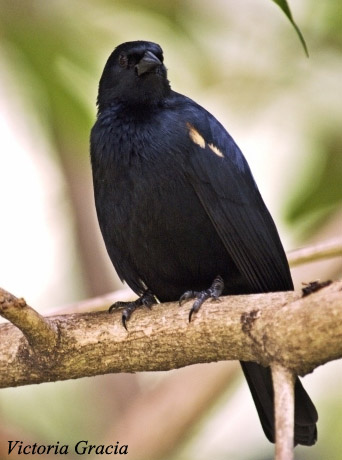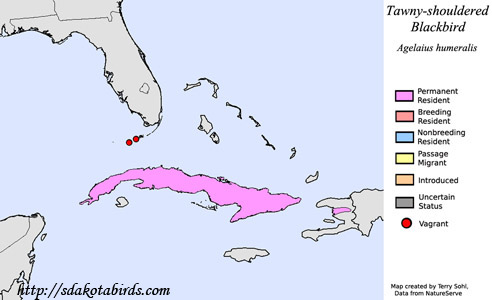| Length: 7.5 inches | Wingspan: 13 1/2 inches | Seasonality: Non-resident in South Dakota |
| ID Keys: (males) Black head, back, tail, undertail, and upper chest. Orange body. | ||
 The
Tawny-shouldered Blackbird is found in Cuba, the Dominican Republic, and
Haiti. They are only rare vagrants to the United States, where the
species has been found in the Florida Keys on rare occasions. They are
named for the brownish-orange patch on their shoulders. They are
similar to the Yellow-shouldered Blackbird, a species also found in the
Caribbean that has a bright yellow shoulder patch that makes it
distinguishable from the Tawny-shouldered Blackbird.
The
Tawny-shouldered Blackbird is found in Cuba, the Dominican Republic, and
Haiti. They are only rare vagrants to the United States, where the
species has been found in the Florida Keys on rare occasions. They are
named for the brownish-orange patch on their shoulders. They are
similar to the Yellow-shouldered Blackbird, a species also found in the
Caribbean that has a bright yellow shoulder patch that makes it
distinguishable from the Tawny-shouldered Blackbird.
Habitat: Found in a variety of habitats, including farmland, open woodlands, forest edges, grassy fields, and marshlands.
Diet: Feeds on grains, seeds, insects, fruits, berries, and nectar. They will also take small vertebrates such as small lizards and young rodents.
Behavior: Uses a variety of foraging techniques dependent upon local food sources. The may feed on the ground, in bushes and shrubs, to up in the tree canopy, but typically are found relatively close to the ground.
Nesting: Tawny-shouldered Blackbirds often nest in loose colonies, with nests placed low in trees or shrubs. The nest is a small cup constructed of various plant fibers, lined with softer material. A clutch typically consists of 3 to 5 eggs.
Song: Tawny-shouldered Blackbirds sing a buzzy song of one or two long notes, often preceded by a short buzzy note. Both sexes will sing in dual courtship.
Migration: Considered a permanent resident throughout their normal range, but short-distance movements are noted.
Feeders: May attend feeders for seeds and grains
Interactive eBird Map: Click here to access an interactive eBird map of Tawny-shouldered Blackbird sightings
Similar Species: Most similar to theYellow-shouldered Blackbird, a species found just to the east in Puerto Rico. Very similar overall to the Red-winged Blackbird that is so common on the U.S. mainland, but is not found within the range of the Tawny-shouldered Blackbird. All of these species are closely related, with shoulder patch characteristics providing the main visual clue to differences between them.
Conservation Status: Populations are considered stable, and the IUCN lists the Tawny-shouldered Blackbird as a species of "Least Concern"
Further Information: 1) BirdLife International - Tawny-shouldered Blackbird
2) Cornell's Neotropical Birds - Tawny-shouldered Blackbird
3) Handbook of the Birds of the World - Tawny-shouldered Blackbird
Photo Information: Photo taken by Victoria Gracia - December 25th, 2011 - Cuba - Photo licensed under Creative Commons Attribution-NonCommercial-ShareAlike 2.0 Generic License
| Click below for a higher-resolution map |
 |
| South Dakota Status: Non-resident in South Dakota |
Additional Tawny-shouldered Blackbird Photos (Coming soon...)
